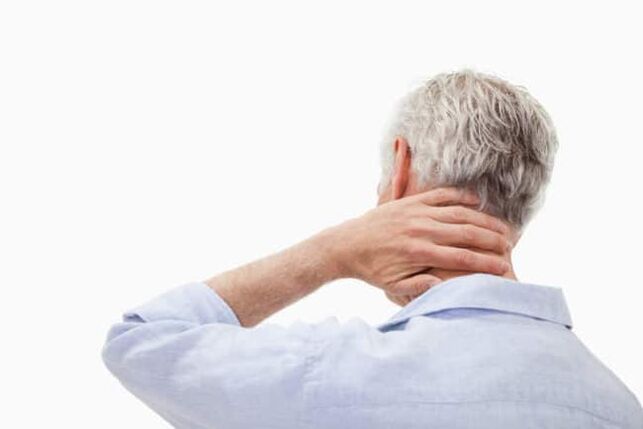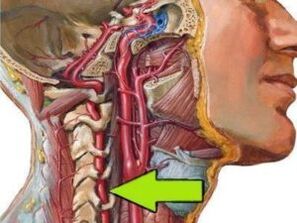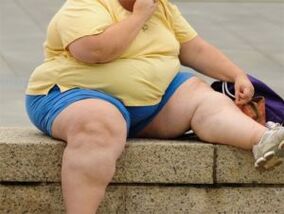Among all pathological processes affecting the spine in different parts, cervical osteochondrosis is considered one of the most common and painful.The disease causes many complications, mainly because it affects the spinal cord, and also adversely affects the functioning of the brain.

What is cervical osteochondrosis?
The words of cervical osteochondrosis in medical practice mean a progressive disease that affects a particular spine.This pathological process is characterized by degenerative dystrophic processes in the tissues of the intervertebral discs, which are cervical vertebral shock absorbers.Degenerative dystrophic changes in intervertebral discs result from the fact that they are deleted and deformed.This reduces the distance between the vertebrae and leads to the following consequences:
- Narrowing of the spinal canal in certain parts of the spine.
- The vertebral arteries pass - large blood vessels that ensure the brain supply of the brain.This results in a deterioration of the brain supply and disrupted in the cervical spinal cord.
- Intervertebral discs can be deformed and smooth.This is due to a separate part of the spinal cord and nerves, more often the nerve roots are compressed.
All of these problems are not only a threat to cerebrovascular damage, painful neck sensations, headaches, etc.The development of osteochondrosis of the cervical region is dangerous to neurological problems, to worsen the central nervous system, and damage the brain tissue.Based on the international classification of diseases, osteochondrosis of the cervical region was attributed to several separate codes.ICB 10 disease code depends on the age of the disease: The disease has been diagnosed:

- M02 - Distrophy of intervertebral discs in adolescence.
- M42.12 is the dystrophic process of the adult neck.
Many factors depend on the age of the patient and the degree of development of the pathological process, such as consequences, complications, symptoms and, of course, the principles of treatment.
Causes
Knowing the development of the cervical region of osteochondrosis of the cervical region can be a decisive role in the diagnosis process, as well as to determine the principles of the fight against the disease.However, before listing the reasons, it is worth saying that doctors distinguish between two factors that determine the development of this pathological process:
- Pathological - Destruction of intervertebral discs and other vertebrates, where nearby tissues, blood vessels and nerve fibers are involved in the pathological process under negative external factors.The more severe these factors and other pathologies, the faster the disease develops.
- Physiological - based on pathology development, mainly age -related changes.We are talking about the natural aging of cartilage tissues in the spinal column, salts, etc.
If we list the more specific causes of cervical osteochondrosis, they are the following:
- Damage to metabolic processes in the body, as well as certain stages of obesity.
- The phenomenon, which is characterized by mobility restriction, is hypodynamics.It is not only because of injuries or diseases, but also a sedentary lifestyle and sitting.
- Cardiovascular pathologies that contribute to reduced cerebral blood flow, pressure changes and other things.
- Incorrect posture, it is a variety of scoliosis, rheumatism and even flat feet.
- Injection of cervical spine.In this case, we are talking about sprains, strikes, bruises.Other spinal tests in developing cervical osteochondrosis may be influenced by the development of cervical osteochondrosis.
- Excessive heavy physical activity in the cervical region caused by intense sports or heavy physical heavy, depending on human activity.
- A sedentary lifestyle is also dangerous because the constant voltage of the cervical spine and the entire spine if you sit wrong or on uncomfortable furniture.
- Cervical spinal hernia, as well as various related diseases.
- Forced long -term head holding in an awkward or unnatural position.In this case, not only the excess muscles occurs, but the spine is also curved in the cervical area.
- Doctors consider constant stress and nerve surges to a very common cause.
- One of the reasons is also considered to be congenital anomalies of spinal structure.

What is the risk to health?
As mentioned earlier, the cervical spine contains not only the spinal cord and various branches of the nerve, but also the vertebral artery supplying the occipital brain, the cerebellum and the medullavic brain.As cervical osteochondrosis progresses, nearby tissues are ignited.In addition, the development of the pathology threatens to squeeze the nerve roots and pass the blood vessels, the consequences are the following:
- Osteochondrosis is accompanied by spinal deformation, which results in narrowing of the brain canal in certain areas.This can cause compression of the spinal cord and nerve branches, which promises serious neurological problems.In severe cases, a person feels pain, even the ability to lose control of individual parts of the body (mainly in the hand or face).
- As already mentioned, the neckline is accompanied by circulatory damage in the brain's occipital region.At the same time, the brain stops receiving oxygen and nutrients in the right amount, and oxygen starvation begins.Circulatory disorders are a real risk of ischemic stroke and various neurological pathologies.
Syndromes
The main syndromes are:
- The spine.
- Vertebral artery.
- Korshka.
- Heart.
It is important to know that each of these symptoms are accompanied by painful sensations of different types, as well as many unfavorable clinical signs.A person may feel dizzy, noise in his ears and much more.

Vertebral syndrome
It talks about the direct relationship between osteochondrosis of the cervical region with bone and cartilage tissue.The symptoms of this type of pathology are also associated with damage to the above tissues:
- Neck movements are partially or completely limited.
- Head movements are accompanied by neck pain.
- X -Ray shows morphological changes in tissue (intervertebral and vertebrae in the body).
It is worth noting that vertebra syndrome is always accompanied by these three clinical signs.If at least 1 of them are not, the diagnosis will be completely different.
Rock syndrome
This occurs when the roots of the spinal cord are damaged.At the same time, the conductivity of the nerve, the person may feel pain or lose the sensitivity of the individual parts of the body or even suffer from paralysis.Depending on which of the 8 radicular pores disrupts the conductivity, the following symptoms are distinguished:
- 1 pair - numbness or pain at the back of the head;
- 3 pair - damage to the chewing reflex, numbness of the tongue and unpleasant sensations behind the ears;
- 4 pair - key pain, damage to the swallowing reflex;
- 5 pair - shoulder tape lesions accompanied by a problem of hand movement;
- 6 pair - the patient begins to feel the pain and melting of the forearm and shoulder blade;
- 7 pair - hands and fingers numb (often arrow and middle);
- 8 pair - problems similar to an object of the past, but numbness is felt in a ring and little finger.
Cardial syndrome
Despite the fact that the pathological process is still localized in the cervical spine, the syndrome has all signs of cardiac pathologies.The clinical picture is as follows:
- Fast pulse.
- Pain in the sternum in the region.
- Respiratory shortness of breath, weakness, lethargy, decrease in performance.
Signs and symptoms of cervical osteochondrosis
In order to consult a doctor in a timely manner, it is necessary to clearly understand the signs of cervical osteochondrosis.In some cases, such knowledge allows you to seek help in the initial stages of the disease when it is easier to treat.In general, the symptoms of cervical spine osteochondrosis are:

- The pain of osteochondrosis is always, only the intensity and frequency are different.It is pain, it is the first clinical sign.Their intensity depends on the progression stage of the disease, in nature they are stupid or compressed.Painful sensations are mainly in the neck of the occipital, but can also radiate in a temporary region, shoulder and hands.
- In most cases, there are damage to the vestibular apparatus.We are talking about frequent dizziness, nausea, impaired movement coordination, uneven gait, loss of space.
- One of the most common clinical signs is the strength of the neck muscles and the stiffness of the movements.It is difficult for a person to look back, lower and throw his head, and moves reacts with the pain of the pain.
- Many patients point out the feeling that the goose bumps are "running through the scalp" or characterized by tingling.
- There is muscle weakness and numbness in the hands.
- Often there are psychological manifestations expressed in depression, drowsiness, sudden change in mood, mood or irritability.
- Due to impaired circulatory and cerebral tissue damage, dizziness increases and ear noise similar to screaming, pulsation, ringing.
- Many patients point to visual disturbances as well as eyeball pain, especially when trying to very much to the left, right, up or down.
It is sometimes possible to determine the degree of development of the pathological process by symptoms.However, it is still not enough to diagnose this in detail and a number of diagnostic tools are needed.
Diagnostic methods
In order to determine the localization and stage of the disease progression, it is necessary to diagnose osteochondrosis of the cervical spine.The following diagnostic methods are required to completely diagnose:
- X -Ray is the main method to determine the degree and localization of the spinal deformation.
- You can use computed tomography to diagnose pathological diagnosis of pathological changes in the vertebrae and intervertebral disc pathological changes.
- MRI (Magnetsonance Imaging) - allows you to thoroughly examine the wheels and vertebrae, set a scale of hernia, protrusions and remaining lesions.
- Dopplerography - At the same time, the study becomes the ability to find a place to compress the artery, to assess the degree of circulatory disorders.
Treatment methods
Treatment of cervical osteochondrosis always means an integrated method.The principles of treatment depend on many factors such as the age of the patient, the stage of the disease development, the brightness of the clinical image, etc.Nevertheless, you cannot do without a doctor in such a situation and you can first consult with a therapist who then referred you to a vertebrologist.In terms of integrated method: cervical osteochondrosis osteochondrosis is treated with drug therapy, physiotherapy, massages, exercise therapy and other methods that should be discussed in more detail.
Drug treatment
The basis of cervical osteochondrosis treatment is the basis of drug therapy, which includes the use of such groups, medicines and medicines:
- Anesthetics - analgesics and antispasmodic.The first directly boring nerve centers thus stop the painful sensations.The latter allows you to relieve the spasm of the neck muscles, to determine the circulation and to inhibit the pain.
- NSAID -NORININE to reduce the inflammatory process, it is necessary for non -steroidal anti -inflammatory drugs, most of which also eliminate pain.Often these drugs are used in gels, ointments that are rubbed into the affected area.
- Musorelaxants are another way to remove muscle spasm in the cervix.
- Chondroprotectors in certain stages of Chop osteochondrosis are mandatory as they contribute to bone tissue restoration.
- Vitamins B - Normalize the metabolic processes of the nerve tissue, improve the conductivity of nerve impulses and contribute to the central nervous system work.
Remember that treatment should only be performed under the supervision of a physician who is responsible for the prescribing of each medicine, as well as the duration of its intake and dose.
Physiotherapy
Cervical osteochondrosis treatment will be many times more effective using some physiotherapy methods:

- Electrophoresis.
- Laser therapy.
- Ultrasound.
- Massage.
Massage therapy is necessarily performed by an experienced health care worker, and treatment is performed at a course of at least 10 sessions.Cervical massages help to normalize blood circulation, restore elasticity, muscle tone, relieve pain, etc.
Manual therapy
Manual therapy is based on the principle of motor functions and mobility between vertebrae.Initially, manipulations are easy to relax the massage, then the doctor claims more and more strength, operates on the neck pressure and turns vertebrae.
The use of Kuznetsov applicator is one of the methods of spinal disease therapy, including osteochondrosis.The effect of adaptation on the cervical area normalizes metabolic processes, relieves pain, increases muscle tone, improves blood circulation, increases nerve tissue, etc. to prevent osteochondrosis, useful for swimming and hanging on a horizontal strip 2-3 minutes by 2-3 minutes by 2-3 minutes by 2-3 minutes by 2-3 minutes by 2-3 minutes by 2-3 minutes by 2-3 minutes by 2-3 minutes by 2-3 minutes by 2-3 minutes by 2-3 minutes 2-3 minutes 2-3 minutes2-3 minutes 2-3 minutes 2-3 minutes 2-3 minutes 2-3 minutes 2-3 minutes 2-3 minutes 2-3 minutes 2-3 minutes 2-3 minutes 2-3 minutes 2-3 minutes 2-3 minutes 2-3 minutes 2-3 minutes 2-3 minutes 2-3 minutes 2-3 minutes 2-3 minutes 2-3 minutes 2-3 minutes 2-3 minutes 2-3 minutes 2-3 minutes 2-3 minutes 2-3 minutes 2-3 minutes 2-3 minutes 2-3 minutes 2-3 minutesminutes.



























































































